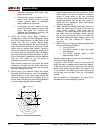
12 www.seektech.com Ridge Tool Company Elyria, Ohio U.S.A
SeekTech SR-60
Figure 15: Highlighting a Desired Frequency (8 kHz)
3. Press the Select Key
(shown below) to
check the box for each frequency to be used.
Figure 16: Select Key
Figure 17: Desired Frequency Checked
Frequencies that have been selected for use will
show a check in the box next to them.
4. Press the Menu Key
again to accept the
choice and exit. Letting the unit countdown
and exit automatically will have the same
effect.
Figure 18: Menu Key
The Main Menu lists all frequencies available for
activation. For information on adding additional
frequencies to the Main Menu so they can be chosen
for activation, see “Frequency Selection Control” on
page
33.
A long press on the Frequency Key
will bring up a
list of all Checked Active Frequencies. To use one,
simply scroll down to it and press the Select Key
.
Note on 93 kHz Frequency Use
The SR-60 offers two 93 kHz frequencies for Line
Tracing. The default 93 kHz frequency has an actual
cycle count of 93,623 cycles per second.
But some older transmitters use a different value for
the nominal 93 kHz frequency, 93,696 cycles per
second. This is found in the SR-60 listed as “93k-B”.
If you find that your transmitter signal at 93 kHz
cannot be detected by the SR-60, set the locator’s
frequency to 93-B kHz, which is set to the older
value. Both 93 and 93-B frequencies can be found
under the Line Trace category of the Frequency
Selection sub-menu.
Sounds of the SR-60
The sound level is driven by the proximity to the
target. The closer to the target, the higher the sound
pitch will be. A rising tone indicates increasing signal.
In Active Line Trace or Passive Line Trace mode,
sound is on one continuous curve and does not re-
scale.
In Line Tracing modes, the default distortion
response also activates an audio signal proportionate
to the distortion in the detected field. When there is
no distortion present, the sound of the SR-60 is a
clear warbling sound when on the left side of the
detected field, with a slight click added when on the
right side of the detected field. If distortion is detected
a sound similar to AM radio static sound can be
heard, which gets stronger as the degree of distortion
increases, similar to the unfocusing that signals
distortion visually around the Tracing Line. If the
distortion response feature is disabled, the static
sound does not occur.
In Sonde Mode, if the sound level reaches its highest
point, it will “re-scale” to a medium level and continue
signaling from the new starting point.
In Sonde Mode, the pitch will “ratchet” upward. That
is, it will rise and then re-scale (fall) in pitch while
approaching the Sonde. Moving away from the
Sonde, it will drop to a lower pitch and remain there
as long as one moves away from the Sonde. Moving
back toward the Sonde again it will resume rising in
steps starting from the level it had reached
previously. This serves as an indication when the


















